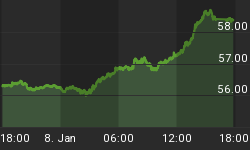Demand for U.S. Treasury bonds has risen even more steadily in 2014 than equities have, and this year's rise in bonds is merely the latest in a series of advances from 2007. We expect bond prices to remain elevated at least through 2015. However, the question of whether they will make a new high depends on a combination of factors. Even though we cannot predict exactly how those factors will balance out, we can sketch two scenarios for bonds going forward.
Primary scenario: bonds make new high
Our primary scenario has bonds seeking a new high sometime in late 2015 or 2016. We favor this projection because the entire advance from 2007 counts well as an Elliott wave ending diagonal pattern, as shown on the first chart below. If the ending diagonal is working, then price needs another decline and rally to finish the pattern.
Several details come together to support the ending-diagonal interpretation. For example, the main structures within the pattern are composed of three-wave moves. The way price has stayed within the channel on the monthly chart also favors counting the eight-year advance as a diagonal. In addition, the dominant 43-month cycle that correctly predicted a low near the start of 2014 also predicts a high around the start of 2016, which would be consistent with a fifth wave in a diagonal.
A closer look at the primary scenario on the weekly timeframe shows resistance levels to watch in the near term. That can be found at our website.

The path shown on the chart above also suggests a story about how different markets will interact in coming months. Concerns about tapering of QE or adjustments to interest rates might begin to weigh more heavily prior to the next Fed meeting, and perhaps afterward. Later in 2015 and in 2016, if it appears that equities are making a serious decline, then bonds may again rise as capital moves out of stocks. In addition, any developments that weaken the value of other important currencies, particularly the Euro, probably would lead to an increase in the value of the U.S. Dollar as well as U.S. Treasury bonds.
Based on other analyses, we expect equities to shift into a bear market trend, or possibly a large correction, starting in autumn 2014. At the same time, our forecast for the U.S. Dollar has it continuing to rise through 2015. In conjunction with those developments, bond prices may benefit from a flight of capital out of equities, and they may also benefit from the U.S. Dollar being seen as even more of a "safe haven" than it is today.
Alternate scenario: bonds make lower highs
However, the fundamental factors mentioned above also allow for an alternate Elliott wave pattern that fails to make a new high. The implication is that bond prices may have peaked in 2012 and may already be working downward, as shown in the second chart below. Ultimately, the answer to whether bonds make a higher high or a lower one will depend on which of the factors mentioned above has the stronger influence.

We favor the alternate count much less, in part because the form of the leading diagonal wave [i] is far from ideal. Nevertheless, if bonds are tracing a downward [i]-[ii]-(i)-(ii) pattern as shown in the second chart, then they should be almost ready to fall into a fairly powerful decline that would reach below the 2013 low. In particular, note that this year's rally has reached the Fibonacci 76.4% retrace level, which would be consistent with the alternate count. In fact, the entire move up from the 2013 low has recognized common retracement levels more than one would expect for an upward motive wave.
The most important clue about which of the two scenarios is taking place probably will reveal itself if price tests the lower parallel. If it pushes decisively below the line, then we will move the alternate scenario to the forefront. We also would watch for a retest of the line as a likely opportunity to establish a short position.
















